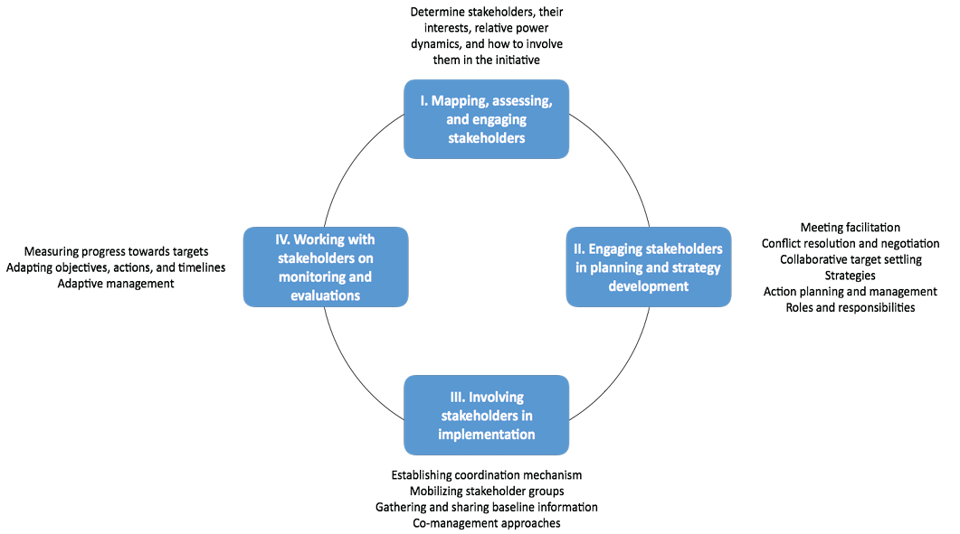4.Stakeholder Participation Processes and Tools
Engaging multiple stakeholders in all stages of environmental management requires that the concept of ‘stakeholder engagement’ is thought of as a process rather than an activity with a clear beginning and end. That is mostly due to the fact that most stakeholders are interacting with natural resources prior to, during, and after the proposed interventions, and as a result their stakes in the issues go far beyond the implications of one single project or initiative. It is also most often the case that there may exist arrangements, conflicts, and issues between various actors engaged in natural resource management that need to be carefully recognized and acknowledged prior to proposing a new course of action. Thus, the process of engaging stakeholders in environmental management and policymaking is iterative and cyclical, requiring that the outcomes and decisions reached in previous iterations be revised frequently to ensure management interventions are addressing changes in evolving socio-ecological conditions.
The process of participation in environmental management and policy primarily seeks to increase understanding about and among stakeholders, while leveraging knowledge and gaining support and commitment from key players. This process eases the adoption of joint resource management between resource users and their institutions to preserve valuable natural capital, strengthen environmental governance, and foster sustainable production. According to the Caribbean Natural Resources Institute (CANARI 2011), effective participatory process should:
•Provide equal, informed, and active access to all stakeholders interested throughout the process,
•Allow stakeholders to present and listen to diverse views and opinions,
•Manage conflicts and build consensus among stakeholders,
•Increase stakeholder understanding of issues through adequate communication, so they are able to make informed decisions,
•Implement adaptive management principles so the process can address emerging needs,
•Seek broad support for the decisions reached and ensure continuity of efforts, and
•Acknowledge and actively balance the differences between stakeholders.
Wealth, social status, customary norms, seniority, age, and gender are some of the factors that influence the relative power of different stakeholders in negotiations during the environmental management process. Thus, negotiation conveners must recognize and compensate the power imbalances that are often at play when different stakeholders are involved in a decision-making process, to ensure fair and just outcomes for all.
The degree of participation in environmental management can also vary widely depending on the power and role of each stakeholder relative to the environmental issue at hand. On one end of the spectrum, users are fully in control of natural resources and decision-making, while on the other end, an agency with authority controls the resources and informs stakeholders of their decisions. In reality, both extremes are seldom effective or pragmatic scenarios for addressing environmental issues. This toolkit proposes arrangements where control over natural resources and decision-making is shared between stakeholders through formalized agreements that detail the roles and responsibilities of various actors. In recent years, multi-stakeholder collaborative working groups, or coordinating mechanisms, have demonstrated their capacity to successfully reach and implement environmental agreements at various scales of decision-making.
Broad stakeholder participation is often reserved for intricate situations with wide-ranging implications for multiple groups of people. Participatory decision-making process works best when: proactive engagement may avert future problems; resource conflicts already exist; decisions affect multiple groups; knowledge from various groups is needed; and, multiple parties have jurisdiction over the resources (NOAA 2003). While it is true that involving stakeholders in environmental management can yield better decisions, increase the support of various actors, and identify options for mutual gain, this process is lengthy and challenging, which implies additional costs for program management (NOAA 2007).
Because environmental management is inherently multidisciplinary, the varying interests at play may conflict through the process, delaying decision-making or making consensus practically impossible. These complexities call for skilled stakeholder participation facilitators with a wide range of experiences, from conflict resolution, to meeting facilitation, to collaborative decision making. However, provided that the process is deemed fair and legitimate by key stakeholders, the benefits of improved relationships between stakeholders often leads to agreements that are respected, implemented, and monitored, which far outweighs the financial and time costs associated with stakeholder participation.
4.2 A Four-Phase Cycle for Participatory Stakeholder Engagement in LME Management

Figure 3: Four-phase Stakeholder Engagement Cycle


























